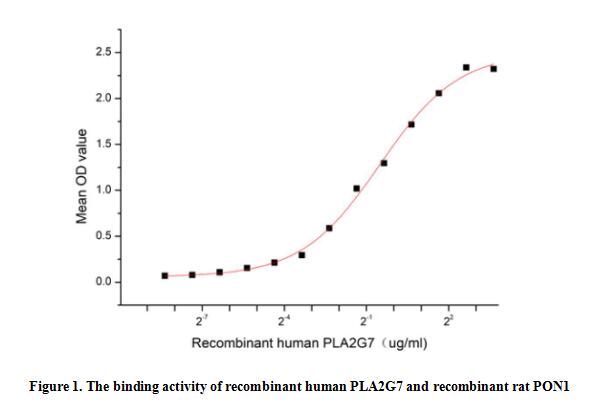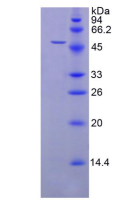Active Phospholipase A2 Group VII (LpPLA2) 

PLA2G7; PAF-AH; PAFAH; Lp-PLA2; LDL-PLA2; Platelet Activating Factor Acetylhydrolase,Plasma; Phospholipase A2,Group VII; LDL-associated phospholipase A2; Phospholipase A2, Lipoprotein Associated
- UOM
- FOB US$ 264.00 US$ 660.00 US$ 1,320.00 US$ 3,960.00 US$ 9,900.00
- Quantity
Overview
Properties
- Product No.APA867Hu01
- Organism SpeciesHomo sapiens (Human) Same name, Different species.
- ApplicationsCell culture; Activity Assays.
Research use only - DownloadInstruction Manual
- CategoryEnzyme & KinaseMetabolic pathwayInfection immunity
- Buffer FormulationPBS, pH7.4, containing 0.01% SKL, 5% Trehalose.
- Traits Freeze-dried powder, Purity > 90%
- Isoelectric Point7.1
Sign into your account
Share a new citation as an author
Upload your experimental result
Review

Contact us
Please fill in the blank.
Activity test

Phospholipase A2 Group VII (PLA2G7) which is also known as Lp-PLA2, is a plasma enzyme bound to lipoproteins: 80% bound to LDL, 15%-20% to HDL, and the remainder to VLDL. It is produced in major by mature macrophages and activated platelets and catalyzes the degradation of platelet-activating factor to biologically inactive products. Besides, Paraoxonase 1 (PON1) has been identified as an interactor of PLA2G7, thus a functional binding ELISA assay was conducted to detect the interaction of recombinant human PLA2G7 and recombinant rat PON1. Briefly, PLA2G7 were diluted serially in PBS, with 0.01% BSA (pH 7.4). Duplicate samples of 100 ul were then transferred to PON1-coated microtiter wells and incubated for 1h at 37℃. Wells were washed with PBST and incubated for 1h with anti-PLA2G7 pAb, then aspirated and washed 3 times. After incubation with HRP labelled secondary antibody, wells were aspirated and washed 5 times. With the addition of substrate solution, wells were incubated 15-25 minutes at 37℃. Finally, add 50µL stop solution to the wells and read at 450/630 nm immediately. The binding activity of recombinant human PLA2G7 and recombinant rat PON1 was shown in Figure 1, the EC50 for this effect is 0.7 ug/mL.
Usage
Reconstitute in 10mM PBS (pH7.4) to a concentration of 0.1-1.0 mg/mL. Do not vortex.
Storage
Avoid repeated freeze/thaw cycles. Store at 2-8°C for one month. Aliquot and store at -80°C for 12 months.
Stability
The thermal stability is described by the loss rate. The loss rate was determined by accelerated thermal degradation test, that is, incubate the protein at 37°C for 48h, and no obvious degradation and precipitation were observed. The loss rate is less than 5% within the expiration date under appropriate storage condition.
Increment services
-
 BCA Protein Quantification Kit
BCA Protein Quantification Kit
-
 Molecular Mass Marker for Protein
Molecular Mass Marker for Protein
-
 Monoclonal Antibody Customized Service
Monoclonal Antibody Customized Service
-
 Polyclonal Antibody Customized Service
Polyclonal Antibody Customized Service
-
 Protein Activity Test Experiment Service
Protein Activity Test Experiment Service
-
 Electrophoretic Mobility Shift Assay (EMSA) Experiment Service
Electrophoretic Mobility Shift Assay (EMSA) Experiment Service
-
 Buffer
Buffer
-
 Lentivirus Packaging Experiment Service
Lentivirus Packaging Experiment Service
-
 Adenovirus Packaging Experiment Service
Adenovirus Packaging Experiment Service
-
 Real Time PCR Experimental Service
Real Time PCR Experimental Service
-
 Spike RBD Protein (S-RBD)
Spike RBD Protein (S-RBD)
-
 Protein G
Protein G
-
 Protein A
Protein A
Citations
- The effects of different intensity walking programs on serum blood lipids, high-sensitive C-reactive protein, and lipoprotein-associated phospholipase A2 in premenopausal womenScienceDirect: S0765159710000262
- Association of Serum Lipoprotein-Associated Phospholipase A2 Level with Nonalcoholic Fatty Liver DiseaseWiley: source
- Effects of Pycnogenol on endothelial function in patients with stable coronary artery disease: a double-blind, randomized, placebo-controlled, cross-over studyPubMed: 22240497
- Effects of Lipid-Lowering Drugs on Irisin in Human Subjects In Vivo and in Human Skeletal Muscle Cells Ex VivoPubMed: PMC3759413
- Influence of Tongfengtai Granules on Inflammatory Factor in Acute Gouty Arthritis Model RatsSource
- Everolimus therapy is associated with reduced lipoprotein-associated phospholipase A2 (Lp-Pla2) activity and oxidative stress in heart transplant recipients.Pubmed: 23958269
- Lipoprotein-Associated Phospholipase A2 Mass Level Is Increased in Elderly Subjects with Type 2 Diabetes MellitusHindawi: 278063
- The Role of Asymmetric Dimethylarginine and Lipoprotein Associated Phospholipase A2 in Children and Adolescents with DyslipidemiaScirp:Source
- In vitro lipid-lowering and fibrinolytic effects of regulatory leucine-containing glyprolines in human bloodSpringer:Source
- Lipoprotein-associated phospholipase A2 and AGEs are associated with cardiovascular risk factors in women with history of gestational diabetes mellitus.Pubmed:24397392
- Lipoprotein-Associated Phospholipase A 2 Mass Level Is Increased in Elderly Subjects with Type 2 Diabetes MellitusPubmed:24818163
- Effects of sitagliptin therapy on markers of low-grade inflammation and cell adhesion molecules in patients with type 2 diabetesPubmed:25034387
- Effect of Extended‐Release Niacin on High‐Density Lipoprotein (HDL) Functionality, Lipoprotein Metabolism, and Mediators of Vascular Inflammation in Statin‐Treated PatientsPubMed: 26374297
- VEbscohost
- Effect of Pitavastatin Treatment on ApoB-48 and Lp-PLA2 in Patients with Metabolic Syndrome: Substudy of PROspective Comparative Clinical Study Evaluating the Efficacy and Safety of PITavastatin in Patients with Metabolic Syndromepmc:PMC4803547
- Effect of dipyridamole on myocardial reperfusion injury: A double‐blind randomized controlled trial in patients undergoing elective coronary artery bypass surgeryPubmed:25773594
- Effect of intensive insulin treatment on plasma levels of lipoprotein-associated phospholipase A 2 and secretory phospholipase A 2 in patients with newly …articles:10.1186
- SERUM LIPOPROTEIN-ASSOCIATED PHOSPHOLIPASE A2 IN MALES WITH METABOLIC SYNDROME AND OBSTRUCTIVE SLEEP APNEA.jrnl:1841098
- Biomarker for diagnosis of moyamoya disease:
- Circulating fatty-acid binding-protein 4 levels predict CV events in patients after coronary interventionsPubmed: 32859455
- Can admission lipoprotein-associated phospholipase A2 predict the symptomatic cerebral vasospasm following aneurysmal subarachnoid hemorrhage?









